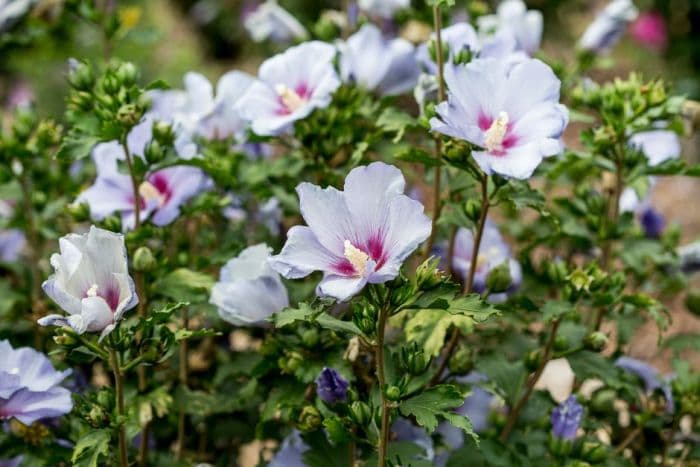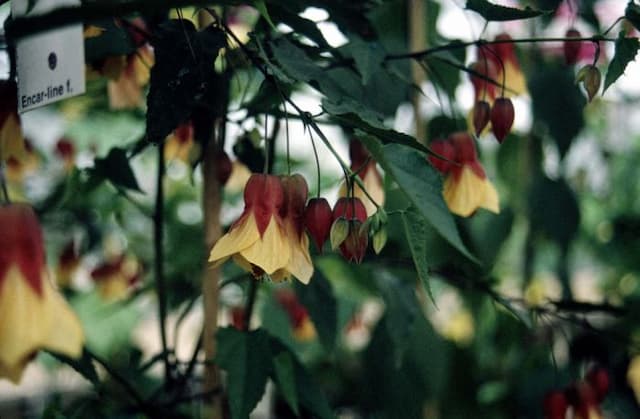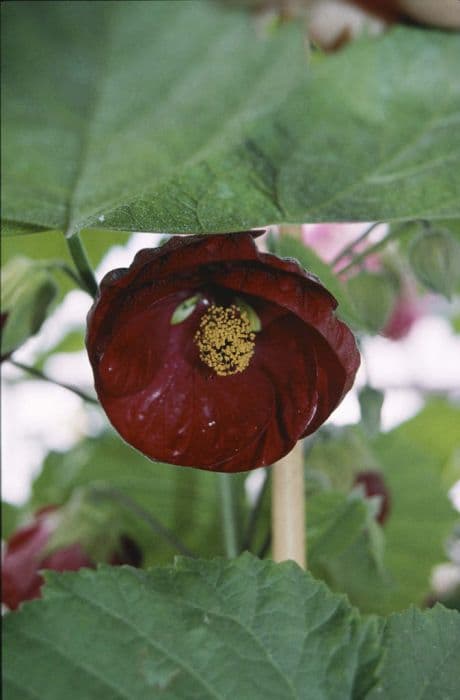Rose of Sharon Hibiscus syriacus 'Coelestis'

ABOUT
The Rose of Sharon 'Coelestis' boasts an exquisite display of pastel blue flowers, each one graced with a prominent central stamen that contrasts with the delicate petal color. The petals themselves are large and have a slightly ruffled appearance, contributing to the overall lush and ornamental quality of the bloom. Foliage on this shrub consists of broad, dark green leaves that create a dense backdrop for the stunning flowers. The leaves may have a somewhat glossy texture, which emphasizes their robustness and adds to the visual appeal of the plant. The Rose of Sharon 'Coelestis' blooms profusely, typically in the late summer through early fall, offering a prolonged period of visual interest. Its hardiness and the generous flowering period make it a favorite among gardeners looking to add lasting color to their landscapes.
About this plant
 Names
NamesSynonyms
Rose Of Sharon, Shrub Althea, Syrian Ketmia, Rose Mallow.
Common names
Althaea frutex, Hibiscus rhombifolius, Ketmia syriaca, Hibiscus floridus
 Toxicity
ToxicityTo humans
Rose of Sharon is generally considered non-toxic to humans. There are no significant symptoms of poisoning associated with the ingestion of this plant. Nonetheless, it is always prudent to avoid ingesting any plant material unless it is known to be safe and intended for human consumption.
To pets
Rose of Sharon is also generally considered to be non-toxic to pets. However, the ingestion of any plant material can potentially cause gastrointestinal upset in pets, such as vomiting or diarrhea. If you suspect your pet has ingested a large amount of this plant and is showing symptoms of distress, it is advisable to contact a veterinarian.
 Characteristics
CharacteristicsLife cycle
Perennials
Foliage type
Deciduous
Color of leaves
Green
Flower color
Blue
Height
8-12 feet (2.4-3.7 meters)
Spread
6-10 feet (1.8-3 meters)
Plant type
Shrub
Hardiness zones
5
Native area
Asia
Benefits
 General Benefits
General Benefits- Attracts Pollinators: Hibiscus syriacus 'Coelestis', commonly known as the Rose of Sharon, attracts bees, butterflies, and other beneficial pollinators, which contribute to the health of your garden ecosystem.
- Ornamental Value: With its large, showy flowers that bloom in summer, the Rose of Sharon provides aesthetic appeal and can serve as a focal point in landscape designs.
- Drought Tolerance: Once established, the Rose of Sharon is relatively tolerant of drought, making it suitable for gardens in drier climates.
- Adaptability: This plant is adaptable to a variety of soil types and conditions, which allows it to thrive in many different garden settings.
- Privacy and Screening: The Rose of Sharon can be used as a hedge or privacy screen due to its upright growth habit and dense foliage.
- Low Maintenance: Requiring minimal care beyond occasional pruning and watering, the Rose of Sharon is a low-maintenance option for gardeners.
- Seasonal Interest: In addition to summer flowers, the plant offers seasonal interest with its changing leaf colors in autumn and its structure during the winter when deciduous.
 Medical Properties
Medical Properties- Anti-inflammatory: It has been traditionally used in some cultures to reduce inflammation.
- Antipyretic: The plant can be employed to lower fever.
- Analgesic: May be used for its pain-relieving properties.
- Diuretic: Hibiscus syriacus 'Coelestis' might be used to increase urine production and relieve fluid retention.
 Air-purifying Qualities
Air-purifying QualitiesThis plant is not specifically known for air purifying qualities.
 Other Uses
Other Uses- As a natural fabric dye: The flowers of the Rose of Sharon can be used to create a natural dye for fabrics, yielding shades of pink, purple, or blue depending on the mordant used.
- In paper making: The fibrous stems of the Rose of Sharon can be processed to create a high-quality, textured paper.
- As an ornamental addition to food: The vibrant flowers can be used to decorate salads or desserts for an attractive, edible garnish.
- In landscaping as a hedge: The Rose of Sharon can be lined up to form dense hedges, providing privacy and a lush appearance to gardens.
- As a natural ink: Juice extracted from the flowers can serve as a botanical ink for artistic or calligraphy purposes.
- For instrument crafting: The wood, known for its fine grain, is sometimes used in the production of certain musical instruments, like the flute.
- As floral arrangements: Both fresh and dried Rose of Sharon flowers can be used in bouquets and flower arrangements to add a splash of color.
- In creating natural potpourri: Dried Rose of Sharon petals can be combined with other herbs and spices to create fragrant, natural potpourri.
- In garden symbolism: Often used in gardens that focus on symbolic planting, it represents delicate beauty or consumed love in the language of flowers.
- As a teaching tool: The Rose of Sharon's distinct flower phases can be used for educational demonstrations in botany and horticulture.
Interesting Facts
 Feng Shui
Feng ShuiThe Rose of Sharon is not used in Feng Shui practice.
 Zodiac Sign Compitability
Zodiac Sign CompitabilityThe Rose of Sharon is not used in astrology practice.
 Plant Symbolism
Plant Symbolism- Delicate Beauty: The Hibiscus is often associated with delicate beauty due to its large, vibrant, and showy flowers that exhibit a subtle grace.
- Carpe Diem: The brief lifespan of hibiscus flowers, which typically only last a day or two, symbolizes the importance of seizing the moment and embracing the transient nature of life.
- Femininity: In some cultures, the hibiscus is a symbol of femininity, representing women's beauty and charm.
- Hospitality: The hibiscus, particularly in the Hawaiian culture, symbolizes hospitality and the friendly welcome of guests.
- Immortality and Eternal Life: In South Korea, where the hibiscus is without Rose of Sharon, it is a national emblem that signifies immortality and is often found in religious and ceremonial contexts.
 Water
WaterRose of Sharon requires consistent moisture and should be watered deeply. During the growing season, water the plant at least once a week, giving the soil a thorough soaking so that water reaches the deep roots. In hot and dry conditions, Rose of Sharon might need additional water. It's crucial to avoid overwatering; make sure the soil is well-draining to prevent waterlogging. A general guideline is to provide the plant with about 1-1.5 gallons of water weekly, depending on the weather and soil conditions.
 Light
LightRose of Sharon thrives in full sun, meaning at least 6 hours of direct sunlight per day. It's important to plant it in a spot where it can receive ample sunlight for healthy growth and flowering. Although it can tolerate partial shade, too little light can lead to fewer blooms and a less robust plant.
 Temperature
TemperatureRose of Sharon is hardy and can withstand a range of temperatures. The ideal temperature for this plant is between 60°F and 90°F. It can survive minimum winter temperatures down to about -10°F but it's best to avoid prolonged exposure to extreme cold.
 Pruning
PruningPruning Rose of Sharon encourages better blooms and a more attractive shape. The best time to prune is late winter or early spring before new growth starts. Annually remove any dead or damaged branches, and you can thin out the plant for better air circulation. You can also cut back last year's growth to promote bushier growth and more flowers.
 Cleaning
CleaningAs needed
 Soil
SoilRose of Sharon prefers well-draining, fertile soil with a pH between 5.5 and 7.5. A mix containing loam, peat, compost, and perlite or sand will ensure good drainage and proper nutrient availability for optimal growth.
 Repotting
RepottingRose of Sharon, typically grown as a shrub in the landscape, does not require frequent repotting. If grown in a container, repotting every 2-3 years or when root-bound is sufficient.
 Humidity & Misting
Humidity & MistingRose of Sharon can tolerate a wide range of humidity levels but thrives best in average humidity conditions. Excessive humidity is not necessary for its well-being and it is quite adaptable in different outdoor environments.
 Suitable locations
Suitable locationsIndoor
Provide bright light and consistent moisture.
Outdoor
Full sun, well-draining soil, and regular watering.
Hardiness zone
5-9 USDA
 Life cycle
Life cycleThe life of Hibiscus syriacus 'Coelestis', commonly known as the Rose of Sharon, begins with seed germination, which typically occurs in the spring when the soil warms up. After germination, the seedling emerges and over the following weeks to months, it develops into a juvenile plant with characteristic lobed leaves. As the plant matures, it enters the vegetative stage, where it grows larger and establishes a substantial root system. Once mature, usually in 2 to 3 years, the Rose of Sharon enters the flowering stage, usually in late spring or early summer, producing large, showy flowers that can be blue, pink, or white. Following pollination, which is often carried out by bees and other insects, the plant develops seed pods that ripen by autumn; these pods eventually dry and open to release seeds for the next generation. During winter, the plant goes into a period of dormancy, with leaves falling off, preserving energy until the next spring.
 Propogation
PropogationPropogation time
Spring-Early Summer
The most popular method for propagating Hibiscus syriacus 'Coelestis', commonly known as Rose of Sharon, is by softwood cuttings. This technique is typically conducted in late spring to early summer when the plant's new growth is still flexible. Cut a 4 to 6-inch-long (10 to 15 cm) section of stem that has several leaves but no flowers, making the cut just below a leaf node. Dip the cut end in rooting hormone powder to encourage root development and then plant the cutting in a pot filled with a well-draining rooting medium, such as a mixture of perlite and peat moss. Keeping the medium moist and the cutting in indirect light, roots should begin to form within several weeks. Once the cutting has established a good root system, it can be transplanted to a more permanent location.









